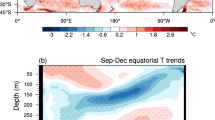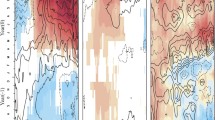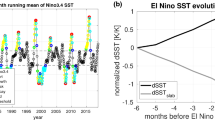Abstract
Why did the predicted “super El Niño” fade out in the summer 2014 and the following year develop into one of the three strongest El Niño on record? Although some hypotheses have been proposed in previous studies, the quantitative contribution of oceanic processes to these events remains unclear. We investigated the role of various oceanic feedbacks, especially in response to intra-seasonal westerly wind busts, in the evolution of the 2014–2016 El Niño events, through a detailed heat budget analysis using high temporal resolution Estimating the Circulation and Climate of the Ocean—Phase II (ECCO2) simulation outputs and satellite-based observations. Results show that the Ekman feedback and zonal advective feedback were the two dominant oceanic processes in the developing phase of the warm event in the spring of 2014 and its decay in June. In the 2015–2016 super El Niño event, the zonal advective feedback and thermocline feedback played a significant role in the eastern Pacific warming. Moreover, the thermocline feedback tended to weaken in the central Pacific where the zonal advection feedback became the dominant positive feedback.
Similar content being viewed by others
References
Bjerknes J. 1969. Atmospheric teleconnections from the equatorial Pacific. Monthly Weather Review; 97(3): 163–172, https://doi.org/10.1175/1520-0493(1969)097<0163:ATFTEP>2.3.CO;2.
Cai W J, Borlace S, Lengaigne M, van Rensch P, Collins M, Vecchi G, Timmermann A, Santoso A, McPhaden M J, Wu L X, England M H, Wang G J, Guilyardi E, Jin F F. 2014. Increasing frequency of extreme El Niño events due to greenhouse warming. Nature Climate Change, 4(2): 111–116, https://doi.org/10.1038/nclimate2100.
Chen D K, Lian T, Fu C B, Cane M A, Tang Y M, Murtugudde R, Song X S, Wu Q Y, Zhou L. 2015. Strong influence of westerly wind bursts on El Niño diversity. Nature Geoscience, 8(5): 339–345, https://doi.org/10.1038/ngeo2399.
Chen L, Li T, Wang B, Wang L. 2017. Formation mechanism for 2015/16 super El Niño. Scientific Report, 7(1): 2 975, https://doi.org/10.1038/s41598-017-02926-3.
Dong L, McPhaden M J. 2018. Unusually warm Indian Ocean sea surface temperatures help to arrest development of El Niño in 2014. Science Reports, 8(1): 2 249, https://doi.org/10.1038/s41598-018-20294-4.
Ducet N, Le Traon P Y, Reverdin G. 2000. Global highresolution mapping of ocean circulation from TOPEX/Poseidon and ERS-1 and -2. Journal of Geophysical Research: Oceans, 105(C8): 19 477–19 498, https://doi.org/10.1029/2000JC900063.
Fedorov A V, Philander S G. 2000. Is El Niño changing? Science, 288(5473): 1 997–2 002, https://doi.org/10.1126/science.288.5473.1997.
Fedorov A V, Philander S G. 2001. A stability analysis of tropical ocean-atmosphere interactions: bridging measurements and theory for El Niño. Journal of Climate, 14(14): 3 086–3 101, https://doi.org/10.1175/1520-0442(2001)014<3086:ASAOTO>2.0.CO;2.
Guan C, Hu S J, McPhaden M J, Wang F, Gao S, Hou Y L. 2019a. Dipole structure of mixed layer salinity in response to El Niño-La Niña asymmetry in the tropical Pacific. Geophysical Research Letters, 46(12): 12 165–12 172, https://doi.org/10.1029/2019GL084817.
Guan C, McPhaden M J, Wang F, Hu S J. 2019b. Quantifying the role of oceanic feedbacks on ENSO asymmetry. Geophysical Research Letters, 46(4): 2 140–2 148, https://doi.org/10.1029/2018GL081332.
Guan C, McPhaden M J. 2016. Ocean processes affecting the twenty-first-century shift in ENSO SST variability. Journal of Climate, 29(19): 6 861–6 879, https://doi.org/10.1175/JCLI-D-15-0870.1.
Halkides D J, Lucas L E, Waliser D E, Lee T, Murtugudde R. 2011. Mechanisms controlling mixed-layer temperature variability in the eastern tropical Pacific on the intraseasonal timescale. Geophysical Research Letters, 38(17): L17602, https://doi.org/10.1029/2011GL048545.
Halpern D, Menemenlis D, Wang X. 2015. Impact of data assimilation on ECCO2 equatorial undercurrent and North equatorial countercurrent in the Pacific Ocean. Journal of Atmospheric & Oceanic Technology, 32(1): 131–143, https://doi.org/10.1175/JTECH-D-14-00025.1.
Harrison D E, Vecchi G A. 1997. Westerly wind events in the Tropical Pacific, 1986–95. Journal of Climate, 10(12): 3 131–3 156, https://doi.org/10.1175/1520-0442(1997)010<3131:WWEITT>2.0.CO;2.
Hu D X, Wu L X, Cai W J, Gupta A S, Ganachaud A, Qiu B, Gordon A L, Lin X P, Chen Z H, Hu S J, Wang G J, Wang Q Y, Sprintall J, Qu T D, Kashino Y, Wang F, Kessler W S. 2015. Pacific western boundary currents and their roles in climate. Nature, 522(7556): 299–308, https://doi.org/10.1038/nature14504.
Hu S J, Hu D X, Guan C, Xing N, Li J P, Feng J Q. 2017. Variability of the western Pacific warm pool structure associated with El Niño. Climate Dynamics, 49(7–8): 2 431–2 449, https://doi.org/10.1007/s00382-016-3459-y.
Hu S N, Fedorov A V. 2016. Exceptionally strong easterly wind burst stalling El Niño of 2014. Proceedings of the National Academy of Sciences of the United States of America, 113(8): 2 005–2 010, https://doi.org/10.1073/pnas.1514182113.
Hu S N, Fedorov A V. 2019. The extreme El Niño of 2015–2016: the role of westerly and easterly wind bursts, and preconditioning by the failed 2014 event. Climate Dynamics, 52(12): 7 339–7 357, https://doi.org/10.1007/s00382-017-3531-2.
Imada Y, Tatebe H, Watanabe M, Ishii M, Kimoto M. 2016. South Pacific influence on the termination of El Niño in 2014. Scientific Report, 6(1): 30 341, https://doi.org/10.1038/srep30341.
Ineson S, Balmaseda M A, Davey M K, Decremer D, Dunstone N J, Gordon M, Ren H L, Scaife A A, Weisheimer A. 2018. Predicting El Niño in 2014 and 2015. Scientific Reports, 8(1): 10 733, https://doi.org/10.1038/s41598-018-29130-1.
Jin F F, Kug J S, An S I, Kang I S. 2003. A near-annual coupled ocean-atmosphere mode in the equatorial Pacific ocean. Geophysical Research Letters, 30(2): 1 080, https://doi.org/10.1029/2002GL015983.
Jin F F. 1997. An equatorial ocean recharge paradigm for ENSO. Part I: Conceptual model. Journal of the Atmospheric Sciences, 54(7): 811–829, https://doi.org/10.1175/1520-0469(1997)054<0811:AEORPF>2.0.CO;2.
Kutsuwada K, McPhaden M J. 2002. Intraseasonal variations in the upper equatorial Pacific Ocean prior to and during the 1997–98 El Niño. Journal of Physical Oceanography, 32(4): 1 133–1 149, https://doi.org/10.1175/1520-0485(2002)032<1133:IVITUE>2.0.CO;2.
Lagerloef G S E, Mitchum G T, Lukas R B, Niiler P P. 1999. Tropical Pacific near-surface currents estimated from altimeter, wind, and drifter data. Journal of Geophysical Research: Oceans, 104(C10): 23 313–23 326, https://doi.org/10.1029/1999JC900197.
Lee T, Fukumori I, Tang B Y. 2004. Temperature advection: internal versus external processes. Journal of Physical Oceanography, 34(8): 1 936–1 944, https://doi.org/10.1175/1520-0485(2004)034<1936:TAIVEP>2.0.CO;2.
Levine A F Z, McPhaden M J. 2016. How the July 2014 easterly wind burst gave the 2015–2016 El Niño a head start. Geophysical Research Letters, 43(12): 6 503–6 510, https://doi.org/10.1002/2016GL069204.
Lian T, Chen D K, Tang Y M, Wu Q Y. 2014. Effects of westerly wind bursts on El Niño: a new perspective. Geophysical Research Letters, 41(10): 3 522–3 527, https://doi.org/10.1002/2014GL059989.
Lim Y K, Kovach R M, Pawson S. Vernieres G. 2017. The 2015/16 El Niño event in context of the MERRA-2 reanalysis: a comparison of the tropical Pacific with 1982/83 and 1997/98. Journal of Climate, 30(13): 4 819–4 842, https://doi.org/10.1175/JCLI-D-16-0800.1.
Maeda S, Urabe Y, Takemura K, Yasuda T, Tanimoto Y. 2016. Active role of the ITCZ and WES feedback in hampering the growth of the expected full-fledged El Niño in 2014. SOLA, 12: 17–21, https://doi.org/10.2151/sola.2016-004.
Marshall A G, Alves O, Hendon H H. 2009. A coupled GCM analysis of MJO activity at the onset of El Niño. Journal of the Atmospheric Sciences, 66(4): 966–983, https://doi.org/10.1175/2008JAS2855.1.
McPhaden M J, Zebiak S E, Glantz M H. 2006. ENSO as an integrating concept in Earth science. Science, 314(5806): 1 740–1 745, https://doi.org/10.1126/science.1132588.
McPhaden M J. 1999. Genesis and evolution of the 1997–98 El Niño. Science, 283(5404): 950–954.
McPhaden M J. 2002. Mixed layer temperature balance on intraseasonal timescales in the Equatorial Pacific Ocean. Journal of Climate, 15(18): 2 632–2 647, https://doi.org/10.1175/1520-0442(2002)015632:MLTBOI>2.0.CO;2.
McPhaden M J. 2015. Playing hide and seek with El Niño. Nature Climate Change, 5(9): 791–795, https://doi.org/10.1038/nclimate2775.
Meinen C S, McPhaden M J. 2000. Observations of warm water volume changes in the equatorial Pacific and their relationship to El Niño and La Nina. Journal of Climate, 13(20): 3 551–3 559, https://doi.org/10.1175/1520-0442(2000)013<3551:OOWWVC>2.0.CO;2.
Menemenlis D, Fukumori I, Lee T. 2005. Using Green’s functions to calibrate an ocean general circulation model. Monthly Weather Review, 133(5): 1 224–1 240, https://doi.org/10.1175/MWR2912.1.
Menkes C E, Lengaigne M, Vialard J, Puy M, Marchesiello P, Cravatte S, Cambon G. 2014. About the role of Westerly Wind Events in the possible development of an El Niño in 2014. Geophysical Research Letters, 41(18): 6 476–6 483, https://doi.org/10.1002/2014GL061186.
Min Q Y, Su J Z, Zhang R H, Rong X Y. 2015. What hindered the El Niño pattern in 2014? Geophysical Research Letters, 42(16): 6 762–6 770, https://doi.org/10.1002/2015GL064899.
Moore A M, Kleeman R. 1999. Stochastic forcing of ENSO by the intraseasonal oscillation. Journal of Climate, 12(5): 1 199–1 220, https://doi.org/10.1175/1520-0442(1999)012<1199:SFOEBT>2.0.CO;2.
Paek H, Yu J Y, Qian C C. 2017. Why were the 2015/2016 and 1997/1998 extreme El Niños different? Geophysical Research Letters, 44(4): 1 848–1 856, https://doi.org/10.1002/2016GL071515.
Pandey V K, Singh S K. 2010. Comparison of ECCO2 and NCEP reanalysis using TRITON and RAMA data at the Indian Ocean Mooring Buoy point. e-Journal of Earth Science India, 3: 226–241.
Puy M, Vialard J, Lengaigne M, Guilyardi E. 2016. Modulation of equatorial Pacific westerly/easterly wind events by the Madden-Julian oscillation and convectively-coupled Rossby waves. Climate Dynamics, 46(7–8): 2 155–2 178, https://doi.org/10.1007/s00382-015-2695-x.
Reynolds R W, Smith T M, Liu C, Chelton D B, Casey K S, Schlax M G. 2007. Daily high-resolution blended analyses for sea surface temperature. Journal of Climate, 20: 5 473–5 496, https://doi.org/10.1175/2007JCLI1824.1.
Ren H L, Wang R, Zhai P M, Ding Y H, Lu B. 2017. Upper-ocean dynamical features and prediction of the super El Niño in 2015/16: a comparison with the cases in 1982/83 and 1997/98. Journal of Meteorological Research, 31(2): 278–294, https://doi.org/10.1007/s13351-017-6194-3.
Santoso A, McPhaden M J, Cai W J. 2017. The defining characteristics of ENSO extremes and the strong 2015/2016 El Niño. Reviews of Geophysics, 55(4): 1 079–1 129, https://doi.org/10.1002/2017RG000560.
Santoso A, McPhaden M J, Cai W J. 2017. The defining characteristics of ENSO extremes and the strong 2015/2016 El Niño. Reviews of Geophysics, 55(4): 1 079–1 129, https://doi.org/10.1002/2017RG000560.
Seiki A, Takayabu Y N. 2007a. Westerly wind bursts and their relationship with intraseasonal variations and ENSO. Part I: statistics. Monthly Weather Review, 135(10): 3 346–3 361, https://doi.org/10.1175/MWR3503.1.
Seiki A, Takayabu Y N. 2007b. Westerly wind bursts and their relationship with intraseasonal variations and ENSO. Part II: energetics over the Western and Central Pacific. Monthly Weather Review, 135: 3 346–3 361, https://doi.org/10.1175/MWR3503.1.
Smith S D. 1988. Coefficients for sea surface wind stress, heat flux, and wind profiles as a function of wind speed and temperature. Journal of Geophysical Research: Oceans, 93(C12): 15 467–15 472, https://doi.org/10.1029/JC093iC12p15467.
Timmermann A, An S I, Kug J S et al. 2018. El Niño-Southern Oscillation complexity. Nature, 559(7715): 535–545, https://doi.org/10.1038/s41586-018-0252-6.
Walters R A, Heston C. 1982. Removing tidal-period variations from time-series data using low-pass digital filters. Journal of Physical Oceanography, 12(1): 112–115, https://doi.org/10.1175/1520-0485(1982)012<0112:RTPVFT>2.0.CO;2.
Wang G M, Hendon H H. 2017. Why 2015 was a strong El Niño and 2014 was not. Geophysical Research Letters, 44(16): 8 567–8 575, https://doi.org/10.1002/2017GL074244.
Wu Y K, Chen L, Hong C C, Li T, Chen C T, Wang L. 2018. Role of the meridional dipole of SSTA and associated cross-equatorial flow in the tropical eastern Pacific in terminating the 2014 El Niño development. Climate Dynamics, 50(5–6): 1 625–1 638, https://doi.org/10.1007/s00382-017-3710-1.
Wyrtki K. 1975. El Niño—the dynamic response of the Equatorial Pacific Oceanto atmospheric forcing. Journal of Physical Oceanography, 5(4): 572–584, https://doi.org/10.1175/1520-0485(1975)005<0572:ENTDRO>2.0.CO;2.
Xu K, Huang R X, Wang W Q, Zhu C W, Lu R Y. 2017. Thermocline fluctuations in the Equatorial Pacific Related to the two types of El Niño events. Journal of Climate, 30(17): 6 611–6 627, https://doi.org/10.1175/jcli-d-16-029L1.
Xue Y, Kumar A. 2017. Evolution of the 2015/16 El Niño and historical perspective since 1979. Science China Earth Sciences, 60(9): 1 572–1 588, https://doi.org/10.1007/s11430-016-0106-9.
Zhai P M, Yu R, Guo Y J, Li Q X, Ren X J, Wang Y Q, Xu W H, Liu Y J, Ding Y H. 2016. The strong El Niño of 2015/16 and its dominant impacts on global and China’s climate. Journal of Meteorological Research, 30(3): 283–297, https://doi.org/10.1007/s13351-016-6101-3.
Zhang C D. 2001. Intraseasonal perturbations in sea surface temperatures of the equatorial eastern Pacific and their association with the Madden-Julian oscillation. Journal of Climate, 14(6): 1 309–1 322, https://doi.org/10.1175/1520-0442(2001)014<1309:IPISST>2.0.CO;2.
Zhang R H, Gao C. 2016. The IOCAS intermediate coupled model (IOCAS ICM) and its real-time predictions of the 2015–2016 El Niño event. Science Bulletin, 61(13): 1 061–1 070, https://doi.org/10.1007/s11434-016-1064-4.
Zhang R H, Gao C. 2017. Processes involved in the second-year warming of the 2015 El Niño event as derived from an intermediate ocean model. Science China Earth Sciences, 60(9): 1 601–1 613, https://doi.org/10.1007/s11430-016-0201-9.
Zhang R H, Zheng F, Zhu J S, Pei Y H, Zheng Q N, Wang Z G. 2012. Modulation of El Niño-southern oscillation by freshwater flux and salinity variability in the Tropical Pacific. Advances in Atmospheric Sciences, 29(4): 647–660, https://doi.org/10.1007/s00376-012-1235-4.
Zhang R H, Zheng F, Zhu J, Wang Z G. 2013. A successful real-time forecast of the 2010–11 La Niña event. Scientific Reports, 3: 1108, https://doi.org/10.1038/srep01108.
Zhang X B, McPhaden M J. 2010. Surface layer heat balance in the Eastern Equatorial Pacific Ocean on interannual time scales: influence of local versus remote wind forcing. Journal of Climate, 23(16): 4 375–4 394, https://doi.org/10.1175/2010JCLI3469.1.
Zheng F, Zhang R H. 2015. Interannually varying salinity effects on ENSO in the tropical Pacific: a diagnostic analysis from Argo. Ocean Dynamics, 65(5): 691–705, https://doi.org/10.1007/s10236-015-0829-7.
Zheng F, Zhu J. 2010. Coupled assimilation for an intermediated coupled ENSO prediction model. Ocean Dynamics, 60(5): 1 061–1 073, https://doi.org/10.1007/s10236-010-0307-1.
Zheng F, Zhu J. 2016. Improved ensemble-mean forecasting of ENSO events by a zero-mean stochastic error model of an intermediate coupled model. Climate Dynamics, 47(12): 3 901–3 915, https://doi.org/10.1007/s00382-016-3048-0.
Zhi H, Zhang R H, Lin P F, Shi S W. 2019. Effects of salinity variability on recent El Niño events. Atmosphere, 10(8): 475, https://doi.org/10.3390/atmos10080475.
Zhong W X, Cai W J, Zheng X T, Yang S. 2019. Unusual anomaly pattern of the 2015/2016 extreme El Niño induced by the 2014 warm condition. Geophysical Research Letters, 46(24): 14 772–14 781, https://doi.org/10.1029/2019GL085681.
Zhu J S, Kumar A, Huang B H, Balmaseda M A, Hu Z Z, Marx L, Kinter III J L. 2016. The role of off-equatorial surface temperature anomalies in the 2014 El Niño prediction. Scientific Report, 6: 19 677, https://doi.org/10.1038/srep19677.
Acknowledgment
We thank Dr. Michael J. McPhaden of NOAA/Pacific Marine Environmental Laboratory for his valuable comments. We acknowledge NOAA and NASA JPL for their valuable observations and model products.
Author information
Authors and Affiliations
Corresponding author
Additional information
Supported by the National Natural Science Foundation of China (No. 41806016) and the China Postdoctoral Science Foundation (No. 2017M622289) to GUAN Cong; the National Natural Science Foundation of China (Nos. 41776018, 91858101) and the Strategic Priority Research Program of Chinese Academy of Sciences (No. XDB01000000) to HU Shijian; the State Key Program of National Natural Science of China (No.41730534) and The NSFC Innovative Group Grant (No. 41421005) to WANG Fan
Data Availability Statement
The OISSTv2 data are available at www.ncdc.noaa.gov, the SSH data are from the AVISO altimeter at www.aviso.altimetry.fr, the wind stress data from NOAA/ERDDAP are at https://coastwatch.pfeg.noaa.gov/erddap, and OSCAR surface ocean current at http://podaac.jpl.nasa.gov. The ECCO2 outputs can be found at ftp://ecco.jpl.nasa.gov/ECCO2.
Rights and permissions
About this article
Cite this article
Guan, C., Wang, F. & Hu, S. The role of oceanic feedbacks in the 2014–2016 El Niño events as derived from ocean reanalysis data. J. Ocean. Limnol. 38, 1394–1407 (2020). https://doi.org/10.1007/s00343-020-0038-1
Received:
Accepted:
Published:
Issue Date:
DOI: https://doi.org/10.1007/s00343-020-0038-1




